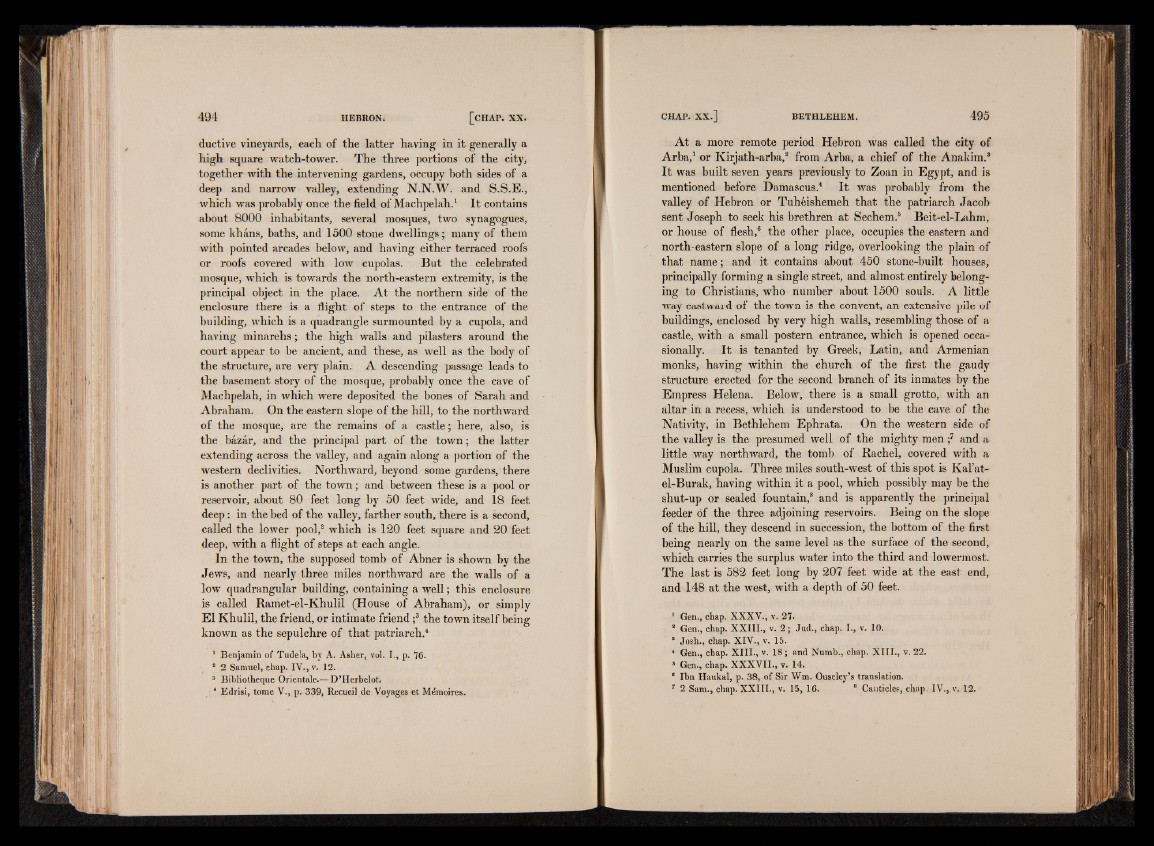
ductive vineyards, each of the latter having in it generally a
high square watch-tower. The three portions of the city,
together with the intervening gardens, occupy both sides of a
deep and narrow valley, extending N.N.W. and S.S.E.,
which was probably once the field of Machpelah.1 It contains
about 8000 inhabitants, several mosques, two synagogues,
some khâns, baths, and 1500 stone dwellings; many of them
with pointed arcades below, and having either terraced roofs
or roofs covered with low cupolas. But the celebrated
mosque, which is towards the north-eastern extremity, is the
principal object in the place. At the northern side of the
enclosure there is a flight of steps to the entrance of the
building, which is a quadrangle surmounted by a cupola, and
having minarehs ; the high walls and pilasters around the
court appear to be ancient, and these, as well as the body of
the structure, are very plain. A descending passage leads to
the basement story of the mosque, probably once the cave of
Machpelah, in which were deposited the bones of Sarah and
Abraham. On the eastern slope of the hill, to the northward
of the mosque, are the remains of a castle; here, also, is
the bâzâr, and the principal part of the town ; the latter
extending across the valley, and again along a portion of the
western declivities. Northward, beyond some gardens, there
is another part of the town ; and between these is a pool or
reservoir, about 80 feet long by 50 feet wide, and 18 feet
deep : in the bed of the valley, farther south, there is a second,
called the lower pool,8 which is 120 feet square and 20 feet
deep, with a flight of steps at each angle.
In the town, the supposed tomb of Abner is shown by the
Jews, and nearly three miles northward are the walls of a
low quadrangular building, containing a well ; this enclosure
is called Ramet-el-Khulil (House of Abraham), or simply
El Khulil, the friend, or intimate friend ;3 the town itself being
known as the sepulchre of that patriarch.4
1 Benjamin of Tudela, by A. Asher, vol. I., p. 76.
2 2 Samuel, chap. IV., v. 12.
3 Bibliothèque Orientale.—D’Herbelot.
* Edrisi, tome V., p. 339, Recueil de Voyages et Mémoires.
At a more remote period Hebron was called the city of
Arba,1 or Kirjath-arba,8 from Arba, a chief of the Anakim.3
It was built seven years previously to Zoan in Egypt, and is
mentioned before Damascus.4 It was probably from the
valley of Hebron or Tuheishemeh that the patriarch Jacob
sent Joseph to seek his brethren at Sechem.5 Beit-el-Lahm,
or house of flesh,6 the other place, occupies the eastern and
north-eastern slope of a long ridge, overlooking the plain of
that name; and it contains about 450 stone-built houses,
principally forming a single street, and almost entirely belonging
to Christians, who number about 1500 souls. A little
way eastward of the town is the convent, an extensive pile of
buildings, enclosed by very high walls, resembling those of a
castle, with a small postern entrance, which is opened occasionally.
It is tenanted by Greek, Latin, and Armenian
monks, having within the church of the first the gaudy
structure erected for the second branch of its inmates by the
Empress Helena. Below, there is a small grotto, with an
altar in a recess, which is understood to be the cave of the
Nativity, in Bethlehem Ephrata. On the western side of
the valley is the presumed well of the mighty men ;7 and a
little way northward, the tomb of Rachel, covered with a
Muslim cupola. Three miles south-west of this spot is Kal’at-
el-Burak, having within it a pool, which possibly may be the
shut-up or sealed fountain,8 and is apparently the principal
feeder of the three adjoining reservoirs. Being on the slope
of the hill, they descend in succession, the bottom of the first
being nearly on the same level as the surface of the second,
which carries the surplus water into the third and lowermost.
The last is 582 feet long by 207 feet wide at the east end,
and 148 at the west, with a depth of 50 feet.
1 Gen., chap. XXXV., v. 27.
2 Gen., chap. XXIII., v. 2 ; Jud., chap. I., v. 10.
3 Josh., chap. XIV., v. 15.
* Gen., chap. XIII., v. 18; and Numb., chap. X III., v. 22.
3 Gen., chap. XXXVII., v. 14.
“ Ibn Haukal, p. 38, of Sir Wm. Ouseley’s translation.
7 2 Sam., chap. XXIII., v. 15, 16. 8 Canticles, chap. IV., v. 12.